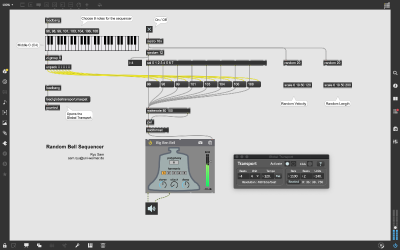No edit summary |
No edit summary |
||
| Line 1: | Line 1: | ||
[[File:Screen Shot 2020-05-03 at 7.13.05 PM.png|400px]] | |||
<Random Bell Sequencer> | |||
1.Description | |||
I'm currently studying acoustics in the media arts department, | |||
So I decided to make a simple random sequencer as the first patch of this term. | |||
Generally, it is a mechanism that controls the operation sequence of a machine by starting the next operation with the signal that one operation has finished with the sequencer. | |||
A mechanism that continuously controls a sequencer and a series of operations in Midi. A peripheral device of a synthesizer, which is an automatic musical instrument. | |||
2. Function | |||
Metro and Counter, | |||
Using these objects in combination with others to create patch which coordinates the playback of sound files over time. | |||
Metro is Metronome, | |||
When turned on, with a toggle, it outputs a bang at | |||
a specified number of millisecond (ms.). This argument can be included in the | |||
object or changed dynamically with a numerical input to the right inlet. | |||
Counter does exactly what I would expect it to: it counts. It takes arguments | |||
for direction (0 - up, 1 - down, 2 - up/down) and a range. This counter, as it's | |||
set up now, counts up from 1 to 4. Take time to look at the help for counter to | |||
find out about all of its other inlets and outlets. | |||
Random only works with integers, but notice that it only | |||
takes a little math to use it to produce floats. | |||
minimum and maximum function similarly. | |||
Used scale in conjunction with a sizable random allows | |||
to produce random numbers in any range. | |||
*[[/PATCH]] | *[[/PATCH]] | ||
Revision as of 17:52, 3 May 2020
<Random Bell Sequencer>
1.Description I'm currently studying acoustics in the media arts department, So I decided to make a simple random sequencer as the first patch of this term.
Generally, it is a mechanism that controls the operation sequence of a machine by starting the next operation with the signal that one operation has finished with the sequencer.
A mechanism that continuously controls a sequencer and a series of operations in Midi. A peripheral device of a synthesizer, which is an automatic musical instrument.
2. Function
Metro and Counter, Using these objects in combination with others to create patch which coordinates the playback of sound files over time.
Metro is Metronome, When turned on, with a toggle, it outputs a bang at a specified number of millisecond (ms.). This argument can be included in the object or changed dynamically with a numerical input to the right inlet.
Counter does exactly what I would expect it to: it counts. It takes arguments for direction (0 - up, 1 - down, 2 - up/down) and a range. This counter, as it's set up now, counts up from 1 to 4. Take time to look at the help for counter to find out about all of its other inlets and outlets.
Random only works with integers, but notice that it only takes a little math to use it to produce floats. minimum and maximum function similarly. Used scale in conjunction with a sizable random allows to produce random numbers in any range.
